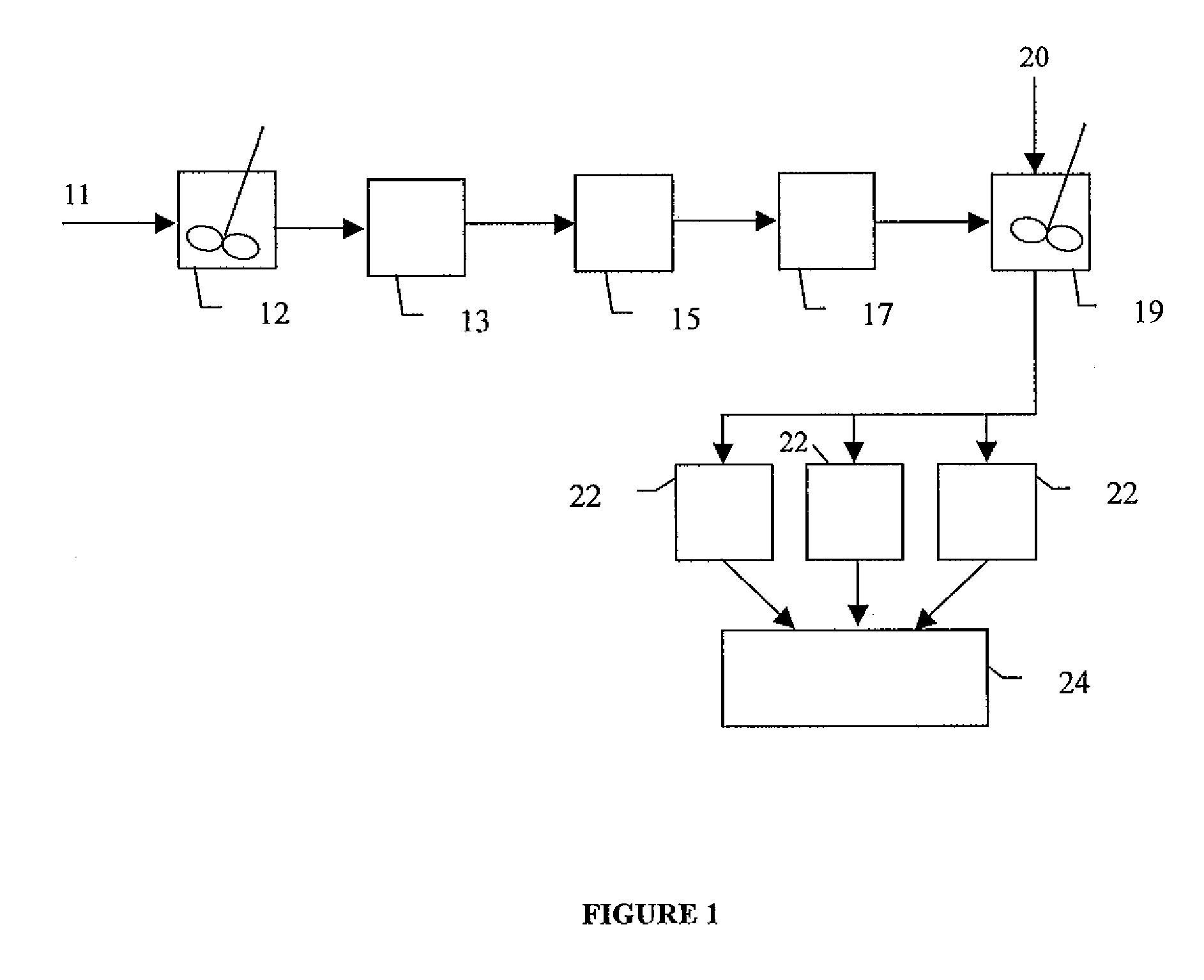Method for continuous production of fermented dairy products
a technology of fermented dairy products and continuous production, which is applied in the field of methods for preparing food products, can solve the problems of large variability in the fermentation time encountered in the production facility producing such products, improper ph readings, and large variability in the production of such products
- Summary
- Abstract
- Description
- Claims
- Application Information
AI Technical Summary
Benefits of technology
Problems solved by technology
Method used
Image
Examples
example 1
[0097]Continuous Fermentation of Yogurt Base
[0098]A typical yogurt base (900 lbs / 40.9 kg) comprising water, non-fat dried milk, crystalline sugar, cream, starch, and gelatin was blended according to the weight percentages in Table 1.
TABLE 1Formula for Typical Yogurt Base 1Ingredients% (w / w)Water70%Non-Fat Dried Milk10%Dry Sugar8%Cream5%Starch4%Gelatin3%Total100%
Homogenization and Pasteurization
[0099]The mixture was homogenized in two stages at 500 psi (3447.4 kilopascal) then 400 psi (2757.9 kilopascal). Next, the yogurt base was pasteurized at 93.3° C. for 20 seconds at a rate of 17.8 lbs per minute (8.1 kg / min).
[0100]After the pasteurization, the yogurt base was cooled to 110° F. (43.3° C.) (AGC Engineering, Chicago, Ill., USA) and pumped into a suitable vessel for continuous fermentation (Waukesha Cherry-Burrell, Delavan, Wis., USA). The temperature in the vessel was maintained at 110° F. (43.3° C.) via heated water in a temperature jacket, the yogurt base ...
example 2
[0108]Determining the Robustness of Continuous Fermentation
[0109]A typical yogurt base comprising of water, non-fat dried milk, crystalline sugar, cream, starch, and gelatin was blended according the weight percentages in Table 2. The mixture was homogenized and pasteurized under standard practices as described in Example 1.
TABLE 2Formula for Typical Yogurt Base 2Ingredients% (w / w)Water70%Non-Fat Dried Milk12%Dry Sugar6%Cream7%Starch4%Gelatin1%Total100%
Continuous Fermentation
[0110]After pasteurization, the base was cooled to 40° F. (4.4° C.) and stored in a chilled reservoir. The mixture was pumped out of the reservoir and heated to 110° F. (43.3° C.) with a crossflow heat exchanger at rate of 23.4 lbs per minute into a suitable vessel for continuous fermentation. The temperature in the vessel was maintained at 110° F. (43.3° C.) via heated water in a temperature jacket. The yogurt base was kept under agitation with a swept surface anchor blade whose arms reached up ⅓ of the vessel ...
example 3
[0116]Fermentation Guided by Viscosity and Exploring Two Different Temperatures in the Sedentary Stage
[0117]A generic highfat yogurt base comprising of water, non-fat dried milk, cream, and starch was blended according the weight percentages in Table 3. The mixture was homogenized and pasteurized under standard practices as described in example 1.
TABLE 3Formula for Generic Yogurt Base 3Ingredients% (w / w)Water87%Non-Fat Dried Milk9%Cream3%Starch1%Total100%
[0118]After pasteurization, the base was cooled to 40° F. (4.4° C.) and stored in a chilled reservoir. The mixture was pumped out of the reservoir and heated to 110° F. (43.3° C.) with a crossflow heat exchanger at rate of 23.4 lbs per minute (10.6 kg / min) into a suitable vessel for continuous fermentation. The temperature in the vessel was maintained at 110° F. (43.3° C.) via heated water in a temperature jacket. The yogurt base was kept under agitation with a pitched blade (20″ (50 cm) A310 Impeller with 1.5″ (3.75 cm) bore, Light...
PUM
 Login to View More
Login to View More Abstract
Description
Claims
Application Information
 Login to View More
Login to View More - R&D
- Intellectual Property
- Life Sciences
- Materials
- Tech Scout
- Unparalleled Data Quality
- Higher Quality Content
- 60% Fewer Hallucinations
Browse by: Latest US Patents, China's latest patents, Technical Efficacy Thesaurus, Application Domain, Technology Topic, Popular Technical Reports.
© 2025 PatSnap. All rights reserved.Legal|Privacy policy|Modern Slavery Act Transparency Statement|Sitemap|About US| Contact US: help@patsnap.com

